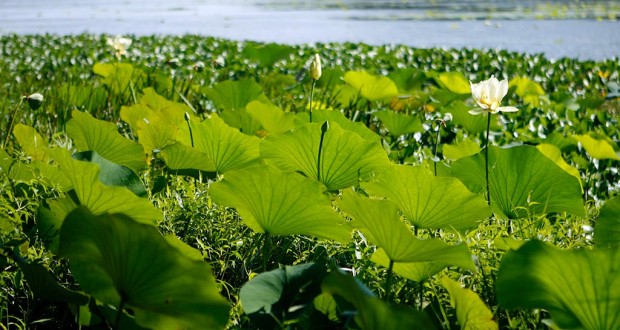The lake does not have broad reaches of open water but three relatively long, narrow arms into which its feeding creeks flow. Signs in the park warn about alligators, but gator sightings are apparently relatively rare.
Tall, lanky loblolly and short leaf pines dominate the park’s forest canopy. But oaks, sweetgum, sassafras, red maples and dogwoods are scattered below, and black willow, river birch, water oaks and elms congregate in the park’s creek bottoms.
According to the park’s birding checklist, wood warblers, thrushes and vireos are common in its patches of hardwood forest during the spring migration in late April and early May, but summer is the busy season, when up to 14 species of warblers are breeding in the park’s woodlands. Overall, the park has recorded more than 218 bird species.
The park’s trails cover diverse terrain, from dappled forest floors matted with pine needles to rolling hills and thriving wetlands:
- The Prairie Branch Loop (1.5 miles) combines the park’s two primary habitats. It begins near the Prairie Branch camping area and enters a mixed pine and hardwood forest, where Loblolly pines reach for the sky. At the halfway point, it dips toward the swampy north end of the lake and turns back to follow the lakeshore. Boardwalks cover ground that gets wetter as the lake rises. In summer, the edge of the lake is a sea of green, covered in lily pads, American Lotus and other shoreline vegetation.
- The Dogwood Trail Loop (1.78 miles) travels through the park’s pine and hardwood woodlands for its entire length, sharing one stretch with the Prairie Branch Loop. In spring, the trees that give the trail its name are spotted with its white flowers.
- The Chinquapin Trail (6.8 miles) circles Raven Lake and the rest of the park, crossing through marshes, forest and lake shore. Boardwalks cover the wetlands at the north end of the trail and cutoffs connect it to the longer Triple C Trail at several points.
- The Triple C Trail (8.5 miles) is the most remote in the park, traveling near the park boundary for most of its length. For a long stretch, it coincides with the Chinquapin Trail. Cutoffs at several points offer an opportunity to shorten the hike.
In addition to the park’s own trails, the lengthy Lone Star Trail extends from the park almost 140 miles into the adjacent Sam Houston National Forest and Pineywoods of East Texas.
Two fishing piers – near the Prairie Branch and Coloneh camping areas – offer striking views of the lake, in addition to fine places to set a pole.


You must be logged in to post a comment.